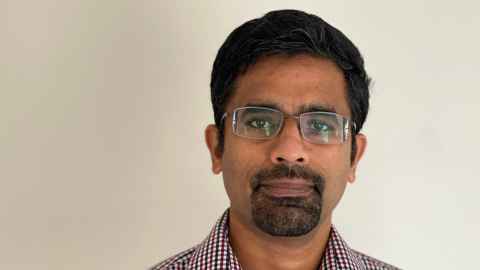Making ventilators safer
14 May 2020
Ventilators have saved the lives of hundreds, if not thousands of people affected by Covid-19, but treating patients with mechanical ventilators is not without risk.

Dr Haribalan Kumar, Auckland Bioengineering Institute (ABI), plans to reduce that risk with a technology that will allow for precise and dynamic monitoring of lung function at the bedside of a patient being treated with a ventilator. He and his team have received $150,000 from the Health Research Council’s Explorer Fund to do so.
A ventilator takes over the body’s breathing process when the lung begins to fail. (For example due to pneumonia, which has affected many Covid-19 patients.) This gives patients time to recover from their condition.
However, ventilation involves pumping high-pressure oxygen into the tiny air sacs of the lung, which can save people’s lives but also cause lung injury, particularly if a patient requires long term treatment, and receives more ventilation than they need.
The monitoring of lung function (and adjusting the ventilators in response) is crucial to avoid ventilator-related injury, particularly in critical care patients.
Such patients need bedside monitoring, but this is currently limited to the monitoring of pressure, volume and blood gases. “In short, it makes it very difficult for clinicians to track how a patient is responding with any precision,” says Dr Kumar.
“It means they can only respond to significant changes in a patient; without more precise monitoring, the greater the risk to a patients to the adverse effects of a ventilator, which can affect them for life”
Dr Kumar aims to develop a technology that will allow for the monitoring of images of a patient’s lung, inside the chest wall, using electrical impedance tomography (EIT).
This involves wrapping a belt of electrodes around the chest to create a real time image of how the lung inflates. EIT is a recently developed technology, and has been hailed as a giant step forward in the monitoring of patients’ response to mechanical ventilation; it’s like an electrocardiogram, for the lungs.
It is not yet being used in New Zealand, and “its efficacy and use is limited because it depends on highly simplified assumptions of lung shape,” says Dr Kumar. He points out that due to differences in individual physiology (age, size, height, underlying health conditions etc.) one lung is not like another, and so one-size monitoring method does not fit all.
In short, it makes it very difficult for clinicians to track how a patient is responding with any precision.
Building upon New Zealand’s reputation in modelling lung physiology and working with international collaborators, he and his team (including Professor Merryn Tawhai and Dr Alys Clark) hope to resolve this issue with a novel patient-specific virtual lung.
This approach will personalise the imaging information, improve its clinical value and its interpretation, reduce risk to patients of ventilator treatment, preserve their lungs and save lives.
“We hope our research will transform EIT from a potentially useful but difficult to interpret technology, to a real-time personalised and readily-interpretable technology,” says Dr Kumar.
“It will transform ventilator management and critical care of mechanically ventilated patients in the ICU, enable rapid intervention, diagnosis and better treatment of lung disease, and reduce the risk of harm that can result from the treatments we do have.”
Media contact
Margo White I Media adviser
DDI 09 923 5504
Mob 021 926 408
Email margo.white@auckland.ac.nz